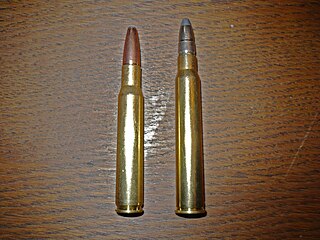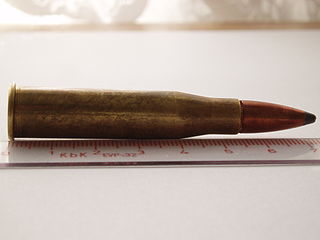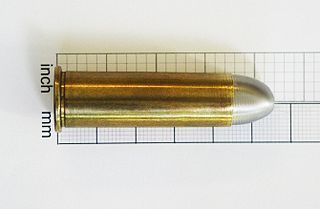 W
WThe .30 R Blaser is a rimmed bottlenecked centerfire cartridge developed for hunting in 1991 by Gerhard Blenk, the then owner of Blaser Jagdwaffen GmbH and Dynamit Nobel which then owned RWS ammunition.
 W
WThe .38 Smith & Wesson Special, also commonly known as .38 S&W Special, .38 Special, .38 Spl, .38 Spc,, or 9x29mmR is a rimmed, centerfire cartridge designed by Smith & Wesson.
 W
WThe .45 Colt, also referred to as .45 Long Colt, .45 LC, or 11.43×33mmR, is a rimmed straight-walled handgun cartridge dating to 1872. It was originally a black-powder revolver round developed for the Colt Single Action Army revolver. This cartridge was adopted by the U.S. Army in 1873 and served as an official US military handgun cartridge for 14 years. It is sometimes referred to as .45 Long Colt or .45 LC, to differentiate it from the very popular .45 ACP, and historically, the shorter .45 S&W Schofield, it was only an unofficial designation by Army quartermasters. Current catalog listings of compatible handguns list the caliber as .45 LC and .45 Colt. Both the Schofield and the .45 Colt were used by the Army at the same period of time prior to the adoption of the M1882 Government version of the .45 Schofield cartridge.
 W
W7.62×38mmR is an ammunition cartridge designed for use in the Russian Nagant M1895 revolver.
 W
WThe 7.62×53mmR rifle cartridge is a Finnish design based on the Russian 7.62×54mmR round dating back to 1891.
 W
WThe 7.62×54mmR is a rimmed rifle cartridge developed by the Russian Empire and introduced as a service cartridge in 1891. Originally designed for the bolt-action Mosin–Nagant rifle, it was used during the late tsarist era and throughout the Soviet period to the present day. The cartridge remains one of the few standard-issue rimmed cartridges still in military use, and has one of the longest service lives of any military-issued cartridge.
 W
WThe 8×56mmR or 8×56mmR M30S cartridge was adopted in the year 1930 by Austria, in 1931 by the Kingdom of Hungary and in 1934 by the Kingdom of Bulgaria as a replacement for the 8×50mmR Mannlicher cartridge.
 W
WThe Soviet 9×53mmR rifle cartridge was designed for hunting in the USSR. It is a 7.62×54mmR necked up to accommodate a larger bullet. Since 1971 two bullet types are available:Type A - SP for hunting 250–500 kg animals Type B - FMJ for hunting 70–250 kg animals
 W
WThe 10.15×61 mmR cartridge was designed by a joint Swedish-Norwegian rifle commission in the late 1870s and early 1880s, and approved for use in Sweden and Norway in 1881. It was primarily used by Norway in the Model 1884 Jarmann rifle, but also saw limited use in Sweden in the m/1867-84 rolling block rifle and carbine. It is a rimmed, centerfire cartridge, and was initially loaded with black powder and a lead bullet wrapped in paper. Later cartridges were loaded with smokeless powder and had a lead bullet coated in steel.
 W
WThe 11×59mmR Gras, also known as the 11mm Vickers, is an obsolete rifle cartridge. France's first modern military cartridge, the 11×59mmR Gras was introduced in 1874 and continued in service in various roles and with various users until after World War II.
 W
WThe 11×58mmR M1877, 11mm Werndl or 11.15×58mmR is a black powder cartridge used in the M1867 Werndl–Holub rifle as well as the Mannlicher M1886 rifle.
 W
WThe .22 Savage Hi-Power cartridge was created by Charles Newton and introduced by Savage Arms in 1912. It was designed to be used in the Savage Model 99 hammerless lever action rifle. It is based upon the .25-35 Winchester cartridge necked down to accept a .227in/.228in diameter bullet. Its original loading was a 70 grain soft point bullet with a velocity of about 2790 feet per second.
 W
WThe .30-30 Winchester/.30 Winchester Center Fire cartridge was first marketed in 1895 for the Winchester Model 1894 lever-action rifle. The .30-30 (thirty-thirty), as it is most commonly known, and the .25-35 were offered that year as the USA's first small-bore sporting rifle cartridges designed for smokeless powder. Sixty years after its introduction, in 1955, it was surpassed by the smaller bore .243 Winchester cartridge with more powerful and accurate ballistics yet similar recoil, but the .30-.30 Winchester remains in widespread use even today.
 W
WThe .30-40 Krag was a cartridge developed in the early 1890s to provide the U.S. armed forces with a smokeless powder cartridge suited for use with modern small-bore repeating rifles to be selected in the 1892 small arm trials. Since the cartridge it was replacing was the .45-70 Government, the round was considered small-bore at the time. The design selected was ultimately the Krag–Jørgensen, formally adopted as the M1892 Springfield. It was also used in M1893 and later Gatling guns.
 W
WThe .38 S&W, also commonly known as .38 S&W Short, it is sometimes referred to as .38 S&W Short to differentiate it from .38 Long Colt and .38 Special, or 9×20mmR is a revolver cartridge developed by Smith & Wesson in 1877. Versions of the cartridge were the standard revolver cartridges of the British military from 1922 to 1963. Though similar in name, it is not interchangeable with the later .38 Special due to a different case shape and slightly larger bullet diameter.
 W
WThe .40-72 Winchester, also known as .40-72 WCF is a centerfire straight-walled rifle cartridge designed for black powder rather than smokeless powder. It was introduced in 1895 for the Winchester 1895 lever-action rifle.
 W
WThe .44-40 Winchester, also known as .44 Winchester, .44 WCF, and .44 Largo was introduced in 1873 by the Winchester Repeating Arms Company. It was the first metallic centerfire cartridge manufactured by Winchester, and was promoted as the standard chambering for the new Winchester Model 1873 rifle. As both a rifle and a handgun caliber, the cartridge soon became widely popular, so much so that the Winchester Model 1873 rifle became known as "The gun that won the West."
 W
WThe .45 Auto Rim, also known as 11.5x23R, is a rimmed cartridge specifically designed to be fired in revolvers originally chambered for the .45 ACP cartridge.
 W
WThe .45-70 rifle cartridge, also known as .45-70 Government, was developed at the U.S. Army's Springfield Armory for use in the Springfield Model 1873, which is known to collectors as the "Trapdoor Springfield." The new cartridge was a replacement for the stop-gap .50-70 Government cartridge, which had been adopted in 1866, one year after the end of the American Civil War.
 W
WThe .50-70 Government is a black powder cartridge adopted in 1866 for the Springfield Model 1866 Trapdoor rifle.
 W
WThe .219 Zipper cartridge was created by Winchester Repeating Arms in 1937 to be used in their lever-action Model 64 rifle. It is a 30-30 Winchester cartridge necked down to a .22 caliber bullet. Marlin Firearms also offered their Marlin Model 336 rifle chambered for the cartridge.
 W
WThe .222 Rimmed is a centrefire rifle cartridge, originating in Australia in the 1960s as a cartridge for single shot rifles, particularly the Martini Cadet action. Performance is similar to the .222 Remington on which it is based however loads should be reduced as the walls of the brass cases are generally thicker. Extraction of cases that have been loaded to higher pressures can be difficult due to the inefficient extraction method utilised by the Martini Cadet.
 W
WThe .303 British or 7.7×56mmR, is a .303-inch (7.7 mm) calibre rimmed rifle cartridge.
 W
WThe .303 Savage is a rimmed, .30 caliber rifle cartridge developed by the Savage Arms Company in 1894 which was designed as a short action cartridge for their Savage Model 1895 later 1899 hammerless lever-action rifle. The cartridge was designed for smokeless powder at a time when black-powder cartridges were still popular. The .303 Savage round was ballistically superior to the .30-30 Winchester, but only marginally. The .303 Savage remained popular through the 1930s. Savage produced a half dozen loads for it. With its 190-grain loading, it was used on such animals as deer and moose.
 W
WThe .307 Winchester cartridge was introduced by Winchester in 1982 to meet the demand of .300 Savage performance in a lever-action rifle equipped with a tubular magazine. It is nearly dimensionally identical to the more common .308 Winchester cartridge, the only differences being a rimmed base and thicker case walls.
 W
WThe .357 Smith & Wesson Magnum, .357 S&W Magnum, .357 Magnum, or 9×33mmR as it is known in unofficial metric designation, is a smokeless powder cartridge with a .357-inch (9.07 mm) bullet diameter. It was created by Elmer Keith, Phillip B. Sharpe, and Douglas B. Wesson of firearm manufacturers Smith & Wesson and Winchester.
 W
WThe .454 Casull is a firearm cartridge, developed as a wildcat cartridge in 1958 by Dick Casull, Duane Marsh and Jack Fullmer. It was first announced in November 1959 by Guns & Ammo magazine. The basic design was a lengthened and structurally improved .45 Colt case. The wildcat cartridge finally went mainstream in 1997, when Ruger began chambering its Super Redhawk in this caliber. Taurus followed with the Raging Bull model in 1998 and the Taurus Raging Judge Magnum in 2010. The .45 Schofield and .45 Colt cartridges can fit into the .454's chambers, but not the other way around because of the lengthened case.
 W
W.455 Webley is a British handgun cartridge, most commonly used in the Webley top break revolvers Marks I through VI. It is also known as ".455 Eley" and ".455 Colt".
 W
WThe .460 S&W Magnum round is a powerful revolver cartridge designed for long-range handgun hunting in the Smith & Wesson Model 460 revolver.